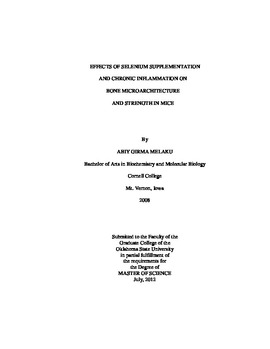| dc.contributor.advisor | Stoecker, Barbara J. | |
| dc.contributor.author | Melaku, Abiy Girma | |
| dc.date.accessioned | 2014-04-15T22:01:21Z | |
| dc.date.available | 2014-04-15T22:01:21Z | |
| dc.date.issued | 2012-07-01 | |
| dc.identifier.uri | https://hdl.handle.net/11244/9249 | |
| dc.description.abstract | The effects of dietary Se and lipopolysaccharide (LPS)-induced inflammation on microarchitecture and strength of bone were investigated in C57BL/6 mice. Timed-pregnant mice were fed a Torula yeast selenium-depletion diet from the final days of gestation through lactation. At 23 days of age, pups were weaned and randomly assigned to the depletion diet or to diets supplemented with a 0.2, 2 or 4 mg/kg diet of Se added as sodium selenate for 14 weeks. At 96 - 98 days of age mice were randomly assigned to placebo or to lipopolysaccharide (E. coli Serotype 0127:B8) treatment to produce chronic inflammation. Time release pellets (0 or 0.1 g/g body weight/d) were implanted subcutaneously. Mice were killed at 120 days of age after an overnight fast. Bone densitometry and organ and body weights were used to determine health status. Se status was assessed through Gpx3 activity, and plasma and liver Se concentration. Micro-CT was used to assess trabecular bone of the fourth lumbar vertebra (L4) and trabecular and cortical bone of tibia. Using finite element analysis a simulated compression test in the z direction was used to assess strength of trabecular cores. Low dose inflammation did not cause significant loss of body weight by necropsy, but LPS tended to increase thymus weight (p = 0.06). Reduced BMD and BMC showed a catabolic state due to LPS (p = 0.02). LPS-treatment tended (p = 0.06) to reduced tibia cortical thickness and increase cortical porosity (p = 0.07), while significantly reducing many parameters of trabecular bone. Inflammation tended (p = 0.07) to increase von Mises stress in tibia trabecular bone, and significantly reduced stiffness in L4. GPx3 activity as well as plasma and liver Se concentration were significantly higher in the Se adequate group than in the Se deficient group, but didn't differ significantly from mice in the highly supplemented groups. Liver weight was significantly reduced in the 4 mg Se/kg group indicating possible toxicity. Contrary to our hypothesis, tibia and L4 trabecular bone parameters in Se deficient mice were significantly improved compared to Se adequate mice and compared with the Se supplemented groups. Tibia biomechanical measurements showed physiological force (p = 0.04) and stiffness (p = 0.04) to be higher, and von Mises stress (0.0001) to be lower in the Se deficient, 2.0 mg/kg and 2.0 mg/kg compared to the Se adequate mice. Interactive effects between LPS and diet in tibial connectivity density and SMI showed LPS to reduce bone strength only in the Se deficient group. Interactions between diet and LPS in average apparent strain, physiological force and von Mises stress of L4 also showed catabolic LPS effects only in the Se deficient and Se adequate groups. Further study in the mechanism of Se action in growing animals needs to be conducted to better explain these results. | |
| dc.format | application/pdf | |
| dc.language | en_US | |
| dc.publisher | Oklahoma State University | |
| dc.rights | Copyright is held by the author who has granted the Oklahoma State University Library the non-exclusive right to share this material in its institutional repository. Contact Digital Library Services at lib-dls@okstate.edu or 405-744-9161 for the permission policy on the use, reproduction or distribution of this material. | |
| dc.title | Effects of Selenium Supplementation and Chronic Inflammation on Bone Microarchitecture and Strength in Mice | |
| dc.type | text | |
| dc.contributor.committeeMember | Smith, Brenda J. | |
| dc.contributor.committeeMember | Clarke, Stephen | |
| osu.filename | Melaku_okstate_0664M_12295.pdf | |
| osu.college | Human Environmental Sciences | |
| osu.accesstype | Open Access | |
| dc.description.department | Department of Nutritional Sciences | |
| dc.type.genre | Thesis | |
